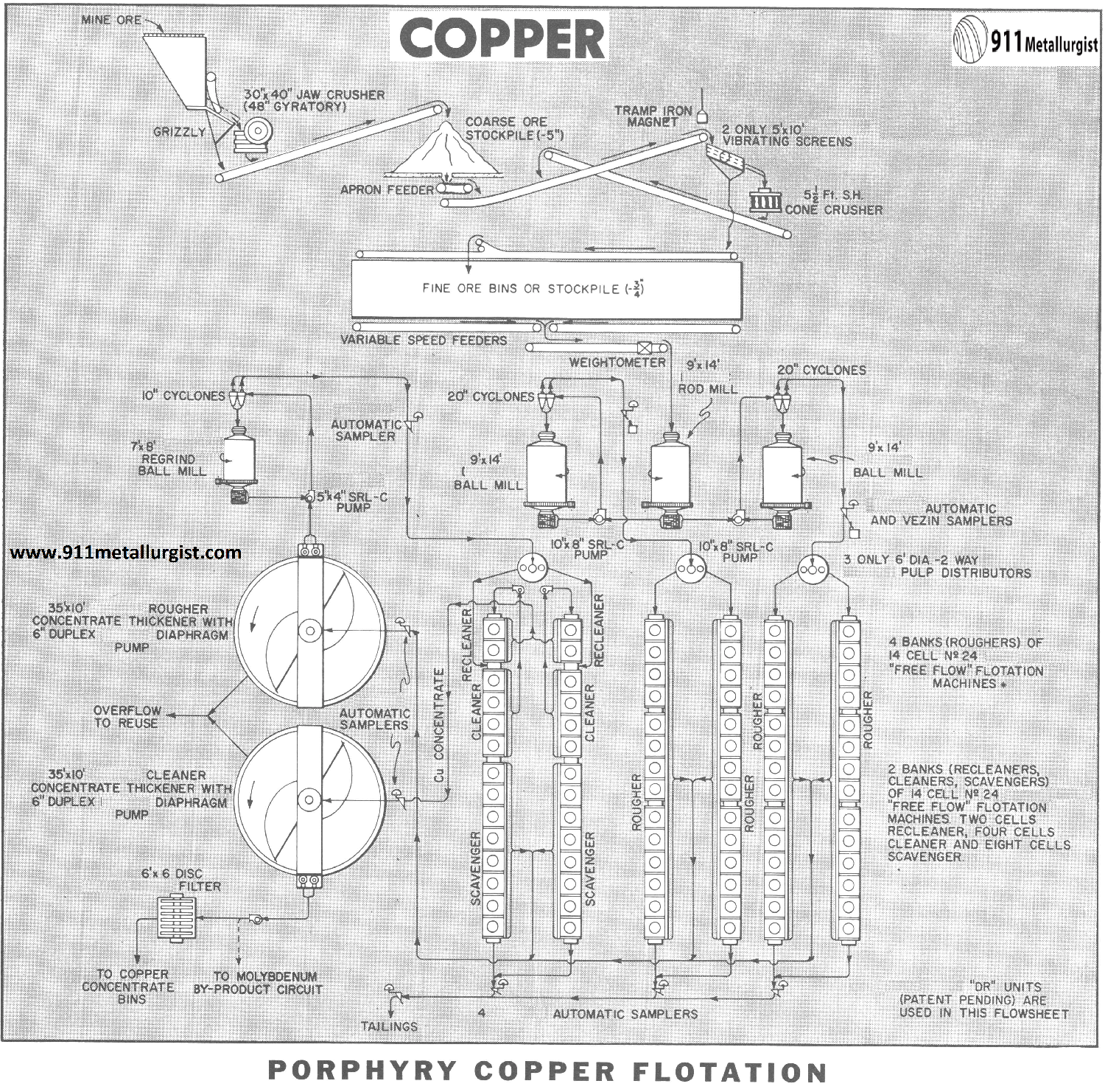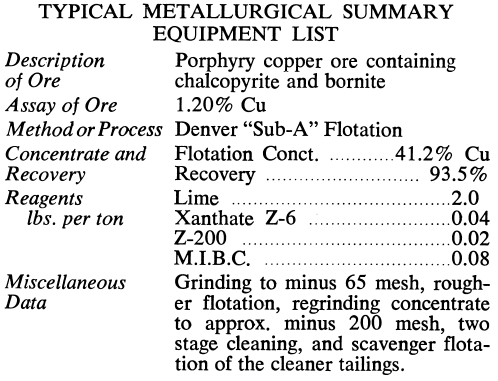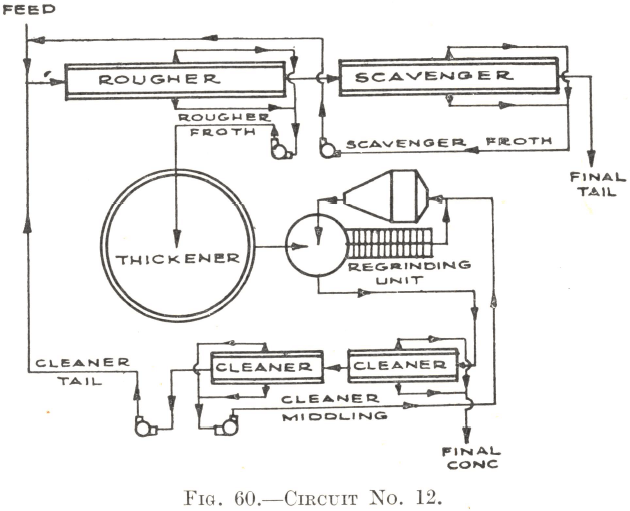Table of Contents
Although basic porphyry copper flotation and metallurgy has remained virtually the same for many years, the processing equipment as well as design of the mills has continually been improved to increase production while reducing operating and maintenance costs. Also, considerable attention is paid to automatic sensing devices and automatic controls in order to assure maximum metallurgy and production at all times. For simplicity in this study most of these controls are not shown. Many of the porphyry copper deposits contain molybdenite and some also contain lead and zinc minerals.
Even though these minerals occur in relatively small amounts they can often be economically recovered as by-products for the expense of mining, crushing, and grinding is absorbed in recovery of the copper.
A Copper Flotation Flowsheet
Because the copper in this type of ore usually assays only plus or minus 1% copper, the porphyry copper operations must be relatively large in order to be commercial. The flowsheet in this study illustrates a typical 3,000 ton per day operation. In general most operations of this type have two or more parallel grinding and flotation circuits. For additional capacity, additional parallel circuits are installed.
COPPER MINING
Open pit mining is generally employed with trucks or train haulage of ore to the nearby concentrator. However, there are a few underground mines using block caving methods.
CRUSHING COPPER ORE
The crushing section consists of two or three crushing stages with the second or third stages in either closed or open circuit with vibrating screens. Generally, size of the primary crusher is not determined by capacity but by the basic size of the mine run rock. The mine-run ore is normally relatively large as most of the porphyry mines are open pit. The crushing section illustrated is designed to handle the full tonnage in approximately 8 to 16 hours thus having reserve capacity in case of expansion.
COPPER ORE STORAGE
Many mills store not only the coarse ore but also the fine ore in open stockpiles using ore as the side walls and drawing the live ore from the center. During prolonged periods of crusher maintenance the ore walls can be bulldozed over the ore feeders to provide an uninterrupted supply of ore for milling.
GRINDING COPPER ORE
As it is shown in this study the ¾” or 1″ crushed ore is fed to a rod mill operating in open circuit and discharging a product approximately minus 14-mesh. The discharge from this primary rod mill is equally distributed to two ball mills which are in closed circuit with SRL Rubber Lined Pumps and two or more cyclone classifiers. The rod mill and two ball mills are approximately the same size for simplified maintenance.
Porphyry copper ores, usually medium to medium hard, require grinding to about 65-mesh to economically liberate the copper minerals from the gangue. Although a clean rougher tailing can often be achieved at 65-mesh the copper mineral is not liberated sufficiently to make a high grade copper concentrate, thus some form of regrinding is necessary on the rougher flotation copper concentrate. It is not unusual to grind the rougher flotation concentrate to minus 200-mesh for more complete liberation of mineral from the gangue.
COPPER FLOTATION CIRCUIT
The cyclone overflow from each ball mill goes to a Pulp Distributor which distributes the pulp to two or more parallel banks of Flotation Cells. These distributors are designed so that one or more flotation banks can be shut down for maintenance or inspection and still maintain equal distribution of feed to the remaining banks.
In some cases it is beneficial to have conditioning before flotation, but this varies from one operation to another and it is not shown in this flowsheet. Ten or more “Free-Flow” Flotation Cells are used per bank and these cells are divided into groups of four or six cells with an intermediate step-down weir between groups. “Free-Flow” Flotation Cells are specified, as metallurgy is extremely good while both maintenance and operating expenses are traditionally low. One or more “Free-Flow” Mechanisms can be stopped for inspection or even replaced for maintenance without shutting down the bank of cells.
The concentrates from rougher flotation cells are sent directly to regrind. Often the grind is 200-mesh. After regrind is flotation cleaning. In some cases the concentrate from the first three or four rougher flotation cells can be sent directly to cleaning without regrinding.
After the rougher flotation concentrate is reground it is cleaned twice in additional “Free-Flow” Flotation Machines with the recleaned concentrate going to final concentrate filtration or, as the metallurgy dictates, to a copper-moly separation circuit.
The tailings or middlings from the flotation cleaning circuit can either go to a cleaner – scavenger circuit as shown on the flowsheet or can be returned to the original rougher flotation cells.
It should be noted that circulating loads and recycle of various products along the circuit is held to a minimum in order to obtain maximum operating control and balances.
COPPER THICKENING AND FILTERING
The thickening and filtering is similar to other milling operations, however, as the porphyry copper installations are often in arid areas, the mill tailing is usually sent to a large thickener for water reclamation and solids go to the tailings dam.
PROCESS CONTROLS
Automatic controls are usually provided throughout modern plants to measure and control pulp flow, pH and density at various points in the circuit. Feed and density controls are relatively common and the newer installations are using automatic pulp level controls on flotation machines and pump sumps. Automation is also being applied to the crushing systems.
The use of continuous on stream X-ray analysis for almost instantaneous metallurgical results is not shown in thus study but warrants careful study for both new and existing mills. Automatic sampling of all principal pulp flows are essential for reliable control.
Copper Flotation Process Summary
The flowsheet in this study illustrates the modern approach to porphyry copper treatment throughout the industry. Each plant will through necessity have somewhat different arrangements or methods for accomplishing the same thing and reliable ore test data are used in most every case to plan the flowsheet and design the mill.

Flotation of Copper Ores
In most plants engaged in the flotation of ores containing copper-bearing sulphide minerals with or without pyrite, pine oil is employed as a frother with one of the xanthates or aerofloat reagents or a combination of two or more of them as the promoter. Lime is nearly always used for maintaining the alkalinity of the circuit and depressing any pyrite present. The reagent consumption is normally within the following limits

While good results are often obtained with ethyl xanthate alone as a promoter, the addition of a small quantity of one of the higher xanthates is frequently found to improve the recovery of those minerals that are not readily floated by the lower xanthate, especially those that are tarnished or oxidized, but since the action of a higher xanthate is, as a rule, more powerful than that of the ethyl compound, it is usually best to add no more of the former reagent than is necessary to bring up the less readily floatable minerals, controlling flotation with the less powerful and more selective lower xanthate. Better results are obtained with some ores by replacing the higher xanthate with one of the dithiophosphates, flotation being controlled, as before, with ethyl xanthate. Sometimes a dithiophosphate can be effectively used without the xanthate, although the dual promotion method is more common. A rule of thumb system for the selection of these reagents cannot be laid down as the character of the minerals differs so widely in different ores ; the best combination can only be found by experiment. When aerofloat is employed alone as the promoter, the reagent mixture is somewhat different from that given above. A reliable average consumption is difficult to determine as the plants working on these lines are few in number, but the following is what would normally be expected. If this combination of reagents gives results equal to those obtainable with a xanthate mixture, its employment has these advantages over the latter method: The control of flotation is not so delicate as with xanthates, it has less tendency to bring up pyrite, and, if selectivity is not required, the circuit may be neutral or only slightly alkaline.
When the ore is free from pyrite, the function of the lime, whatever the reagent mixture, is to precipitate dissolved salts and to maintain the alkalinity of the pulp at the value which has been found to give the best results ; soda ash is seldom employed for this purpose. When pyrite is present, lime performs the additional function of a depressor, the amount used being balanced against that of the promoter—that is, no more lime should be added than is required to prevent the bulk of the pyrite from floating, as any excess tends to depress the copper minerals, and no more of the promoter should be employed than is needed to give a profitable recovery of the valuable minerals in a concentrate of the desired grade, since any excess tends to bring up pyrite. In many cases a more effective method of depressing pyrite is to add a small quantity of sodium cyanide—e.g., 0.05-0.10 lb. per ton—in conjunction with lime, less of the latter reagent then being necessary than if it were used alone.
It is not often that a conditioning tank has to be installed ahead of the flotation section in the treatment of sulphide copper ores, as the grinding circuit usually provides suitable points for the introduction of the reagents. The normal practice is to put lime into the primary ball mills and to add xanthates at the last possible moment before flotation, while aerofloat and di-thio-phosphates are preferably introduced at some point in the grinding circuit, since they generally need an appreciable time of contact as compared with xanthates. There is no special place for the addition of pine oil, but care should be taken if it is put into the primary ball mills, as a slight excess may cause an undue amount of froth to form in the classifiers.
In a plant where the primary slime is by-passed round the grinding circuit, it is necessary to ensure that this portion of the pulp receives its correct proportion of and contact time with the reagents.
As regards flotation installations, the present tendency is to employ machines of the air-lift or Callow-Maclntosh rather than of the subaeration type. While two stages of cleaning (circuits 10 and 11) are sometimes essential to the production of a clean final concentrate, circuits 8 and 9 comprising a single stage of cleaning are probably the most widely used. Occasionally the primary machines can be run as rougher-cleaner cells (circuit No. 5), particularly when they are of the air-lift or subaeration type. This method, however, is not often employed, although its use is more common in the flotation of copper sulphide minerals than of any other class of ore ; a stage of cleaning is preferable as providing greater lattitude of control.
Two variations of normal procedure are worth notice. In one or two plants employing two-stage grinding, improved results have been obtained by separating the slime from the primary ball mill circuit and sending it direct to a special flotation section. This method is useful when the feed to the flotation plant contains an appreciable quantity of fines, which, due generally to oxidation through exposure, require different treatment from the unweathered part of the ore. Such fines are usually friable and can be separated as slime from the primary grinding circuit without the inclusion of an undue proportion of unoxidized material, the bulk of which thus passes to the secondary grinding circuit and thence to its own division of the flotation plant.
The second variation consists of grinding the rougher concentrate before cleaning. The method is applicable to an ore in which the copper- bearing minerals are so intimately associated with pyrite that very fine grinding is necessary to liberate them completely. It is often possible, after grinding such an ore to a comparatively coarse mesh, to make a profitable recovery of the copper in a low-grade concentrate which does not represent too large a proportion, say 30% or less, of the total weight of the feed. The concentrate can then be reground and refloated with the production of a high-grade copper concentrate together with a low- grade pyritic tailing suitable for return to the roughing circuit. This method is likely to be less costly than one involving the fine grinding of the whole ore. No standard system can be given for handling the various products as their disposal depends so much on the occurrence of the minerals and the efficiency of the regrinding operations, but a typical flow sheet is illustrated in circuit No. 12 (Fig. 60). It is diagrammatic to the extent that the thickener and regrinding unit may receive its feed from several roughing machines and deliver its discharge to a number of cleaning cells. It is usual to dewater the rougher concentrate and return the water to the primary circuit for two reasons : First, to supply the regrinding mill with a thick enough pulp for efficient operation, and, secondly, as far as possible to prevent the reagents used in the roughing circuit from entering the cleaning section.
In normal practice a recovery of over 90% of the copper which is present as a sulphide is generally possible, whatever the flotation process or circuit employed. As regards the average grade of concentrate, no more can be said than that it depends on the class of the copper-bearing minerals present and their mode of occurrence and on the character of the gangue. It usually contains over 20% of copper, but a difficult chalcopyritic ore may yield a concentrate with less than that percentage, while it is theoretically possible to obtain one running over 75% should the mineral consist entirely of pure chalcocite.
The flotation of native copper ores is nearly always preceded by gravity concentration in jigs and tables not only because the combined process is more economical as regards costs, but also because the copper often occurs as large grains which flatten out during grinding and cannot be broken to a size small enough for flotation. The flow sheet depends on the mode of occurrence of the mineral. The tailings from some of the gravity concentration machines may be low enough in value to be discarded, but those products which still contain too much copper to be sent to waste are thickened and reground, should either operation be necessary, and then floated with pine oil and a xanthate or aerofloat reagent in a neutral or slightly alkaline circuit. The reagent consumption is approximately the same as that given for the treatment of copper- bearing sulphides. While a pine oil, lime, and ethyl xanthate mixture has proved satisfactory, better results have sometimes been obtained by the substitution of aerofloat and sodium di-ethyl-di-thio-phosphate, soda ash being used instead of lime on account of its gangue deflocculating properties. On the average 0-12 lb. per ton of aerofloat and 0.03 lb. of the di-thio-phosphate are substituted for 0.1 lb. of xanthate.
Since a high-grade concentrate is desired in order to keep smelting costs as low as possible, the circuit usually comprises two stages of cleaning. In most plants flotation is carried out in mechanically agitated machines.
The problem of the flotation of oxidized copper ores has not yet been solved. One or two special processes are in operation for the flotation of malachite and azurite, but none of them has more than a limited application; nor has any method been worked out on a large scale for the bulk flotation of mixed oxidized and sulphide copper minerals when the former are present in the ore in appreciable quantity.
Source: This article is a reproduction of an excerpt of “In the Public Domain” documents held in 911Metallurgy Corp’s private library.
